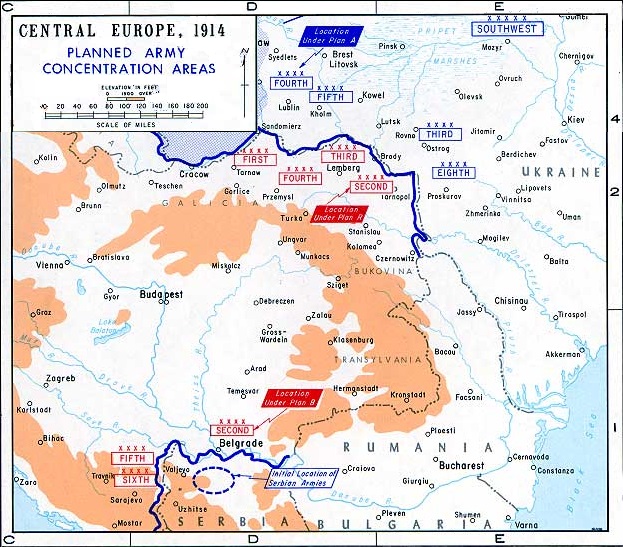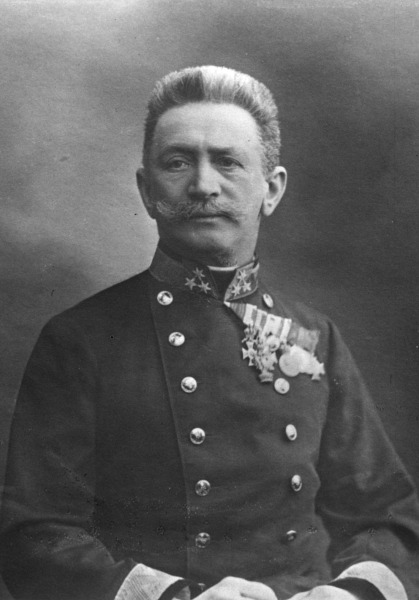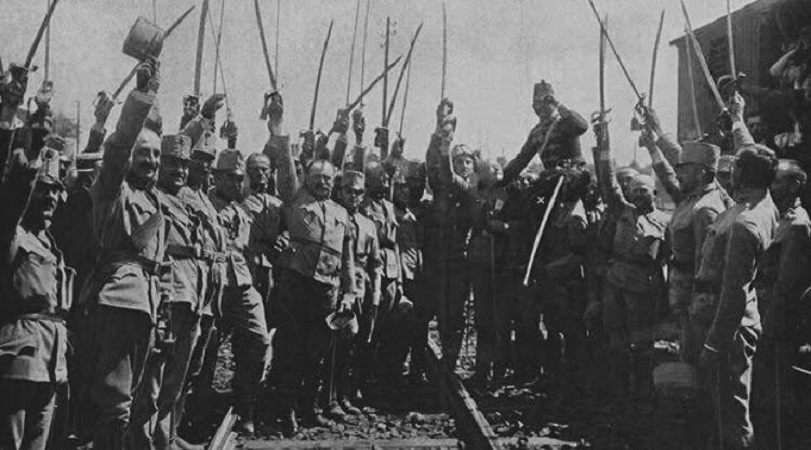● ● ●
For clarity, Austrian formations
are rendered in italics.
The success of the German
war plan—maximum effort in the West, minimum defense in the
East—depended in large part on the cooperation of the
Austro-Hungarian ally. Staff talks before the war had
produced agreement in principle that in the event of a
general European war, Austria-Hungary would launch an
offensive against Russia from Galicia, thus relieving the
pressure on the German Army in East Prussia. The Austrian
Chief of Staff, General of Infantry Franz Graf Conrad von
Hötzendorf, confirmed this arrangement to his German
counterpart only months before war broke out in August 1914.
Privately, however, Conrad
was a prey to uncertainty over Austria-Hungary’s best course
of action. Admittedly, the strategic problem before him was
a difficult one. It seemed likely that the coming war would
begin in the Balkans with a clash between Austria and
Serbia. In Vienna the Serbian kingdom with its designs on
the Slavic provinces of the Habsburg Monarchy was seen as an
existential threat, the elimination of which must be the
primary Austrian war aim. If the war remained localized,
well and good: Serbia could be crushed with ease. But if Russia came in everything would
change. The agreement with Germany, not to mention the
magnitude of the Russian threat, would require the greatest
possible concentration of forces in Galicia. But though
militarily Serbia was much the lesser threat, emotionally
she was regarded as the main enemy by almost all Austro-Hungarian
soldiers and statesmen.

Map: Department of History,
USMA West Point
To
cope with these contingencies, the Austro-Hungarian
mobilization scheme (see map) divided the Army in three: A-Staffel,
(thirty infantry divisions and eight cavalry divisions) would go to
Galicia. Minimalgruppe Balkan, (eight infantry divisions
and some cavalry) would deploy against Serbia. B-Staffel
(ten infantry divisions and two cavalry divisions) was the
strategic reserve, to be directed against either Serbia or
Russia as the situation dictated. If the war remained
localized, B-Staffel would deploy against Serbia; if it
became general, B-Staffel would go to Galicia,
against Russia. The railway timetables, heart of the
mobilization plan, were carefully plotted to allow for an
independent movement by B-Staffel. Supposedly, this
arrangement insured the flexibility necessary to cope with
contingency. But in fact Conrad was determined to “strike
Serbia down with rapid blows” in the first weeks of the
war regardless of the overall situation—an intention that he concealed from his counterpart in
Berlin.
Thus in August 1914 the German
High Command expected the main body of the Austro-Hungarian
Army—A-Staffel and B-Staffel with forty infantry
divisions and ten cavalry divisions—to deploy well forward in
Galicia, poised for an offensive. It was with consternation,
therefore, that Moltke learned of Conrad’s intention to
launch an immediate attack on Serbia. For this purpose the
latter had sent most of B-Staffel, now designated
Second Army, to reinforce Minimalgruppe Balkan,
now designated Fifth and Sixth Armies.
What was more, the three armies of A-Staffel were now
to deploy well inside Galicia, there to await a Russian
offensive.
Though it violated the
accord with Germany, a defensive deployment in Galicia made
good military sense. The
Austro-Hungarian Army
was small and poorly armed,
particularly in terms of artillery. The always-exiguous
prewar military budgets had stymied rearmament plans and
reduced the annual intake of conscripts to a fraction of
those eligible. As a result, reserves of weapons, munitions
and trained men were scanty. Heavy losses in the first
months of war, particularly of professional officers and
NCOs, could never be made good, and that would cripple the
Army. So to take up a strong defensive position in
Galicia seemed much the wiser course of action. If the
invading Russians were successfully repulsed,
an Austrian counteroffensive might then be mounted.

General of Infantry Franz Graf Conrad von Hötzendorf,
Austro-Hungarian Chief of Staff (Wikimedia Commons)
Pushed and pulled by these
contradictory considerations, Conrad took refuge in
dithering—with unfortunate results for Austro-Hungarian
mobilization. Insistent German protests against a defensive
deployment in Galicia, culminating in a direct appeal from
Kaiser Wilhelm to the Emperor Franz Josef, forced the
Austrian Chief of Staff to shift to an offensive deployment
in Galicia after all—this after the troops of A-Staffel had detrained far
from the frontier. To reach their new positions, they were
forced to march forward on foot and horseback over distances
of up to 200 miles, exhausting men and horses in the
process. Then, as the Austrian offensive against Serbia
developed, Conrad sent most of Second Army to Galicia
after all—thus robbing the attack on Serbia of the strength
necessary to ensure success. And crowning this tale of
muddle and indecision, Second Army arrived in Galicia
too late to influence the course of events there.
The Russians, meanwhile,
were completing their deployments against East Prussia and
Galicia. Southwest Front was responsible for the Galician
offensive, controlling four armies with 64 infantry
and cavalry divisions, a force considerably
larger than the Austrians could muster and one that would be
further strengthened by troops transferred from points east.
The shortages of weapons and munitions that would later
plague the Russian Army were yet to emerge and supplies were
ample for the initial campaign. The Russian plan was,
broadly, to defeat the Austrians in Galicia and debouch onto
the Hungarian plain via the Carpathian passes, thus dealing
a death blow to the Habsburg Monarchy.
After some preliminary
cavalry skirmishes the battle for Galicia commenced on 22
August 1914 and its course would do much to determine the
outcome of the Great War.



